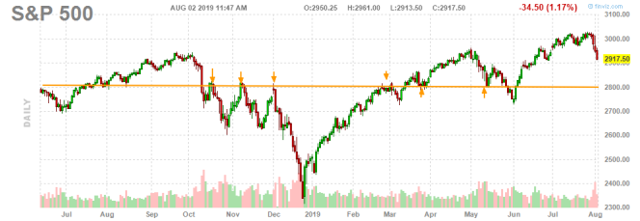I measure once a month the decay of major leveraged ETFs. It may be useful for anyone using leveraged ETFs for investing, trading or hedging.
Where does the decay come from?
Most of the time, a leveraged ETF does worse than the underlying asset leveraged by the same factor. This relative decay has several reasons: beta-slippage, roll yield, tracking errors, and management fees. Only the latter is predictable. Roll yield may be prominent for commodity ETFs (leveraged or not), but beta-slippage is usually the main reason of decay. However, it doesn't always result in decay. When an asset is trending with little volatility, a leveraged ETF can bring an excess return over the leveraged asset. You can click here to learn more about beta-slippage and examples.
The leveraged ETF decay looks like an invitation to short sellers. Click here if you want to know why it is bad idea.
Monthly and Yearly Drifts on 8/2/2019
Definitions are needed. "Lev" is the leveraging factor. "Return" is the total return of an ETF (including dividends). "IndexReturn" is the total return of the underlying index, measured on a non-leveraged ETF (also with dividends). "ETFdrift" is the drift of the ETF relative to the leveraged index. "TradeDrift" is the drift relative to an equivalent position in the non-leveraged index. ETFdrift and TradeDrift are calculated as followed, where Abs is the absolute value operator.
ETFdrift = Return - (IndexReturn x Lev)
TradeDrift = ETFdrift / Abs(Lev.)
"Decay" is negative drift. "Month" stands for 21 trading days; "year" for 252 trading days.
A drift is a difference between 2 returns, so it can be below -100%.
|
Index |
Lev. |
Ticker |
1-month Return |
1-month ETFdrift |
1-month TradeDrift |
1-year Return |
1-year ETFdrift |
1-year TradeDrift |
|
S&P 500 |
1 |
-0.54% |
0.00% |
0.00% |
6.88% |
0.00% |
0.00% |
|
|
3 |
-2.32% |
-0.70% |
-0.23% |
6.37% |
-14.27% |
-4.76% |
||
|
-3 |
2.08% |
0.46% |
0.15% |
-22.15% |
-1.51% |
-0.50% |
||
|
ICE US20+ T Bond |
1 |
1.70% |
0.00% |
0.00% |
16.26% |
0.00% |
0.00% |
|
|
3 |
4.34% |
-0.76% |
-0.25% |
45.37% |
-3.41% |
-1.14% |
||
|
-3 |
-4.95% |
0.15% |
0.05% |
-35.58% |
13.20% |
4.40% |
||
|
NASDAQ 100 |
1 |
0.07% |
0.00% |
0.00% |
8.70% |
0.00% |
0.00% |
|
|
3 |
-0.51% |
-0.72% |
-0.24% |
5.47% |
-20.63% |
-6.88% |
||
|
-3 |
-0.30% |
-0.09% |
-0.03% |
-35.64% |
-9.54% |
-3.18% |
||
|
DJ 30 |
1 |
-0.63% |
0.00% |
0.00% |
6.85% |
0.00% |
0.00% |
|
|
3 |
-2.47% |
-0.58% |
-0.19% |
6.54% |
-14.01% |
-4.67% |
||
|
-3 |
2.37% |
0.48% |
0.16% |
-22.62% |
-2.07% |
-0.69% |
||
|
Russell 2000 |
1 |
-0.55% |
0.00% |
0.00% |
-5.84% |
0.00% |
0.00% |
|
|
3 |
-2.60% |
-0.95% |
-0.32% |
-29.31% |
-11.79% |
-3.93% |
||
|
-3 |
1.66% |
0.01% |
0.00% |
5.99% |
-11.53% |
-3.84% |
||
|
S&P Select Energy |
1 |
-2.34% |
0.00% |
0.00% |
-17.87% |
0.00% |
0.00% |
|
|
3 |
-7.74% |
-0.72% |
-0.24% |
-54.95% |
-1.34% |
-0.45% |
||
|
-3 |
7.18% |
0.16% |
0.05% |
51.06% |
-2.55% |
-0.85% |
||
|
MSCI US REIT |
1 |
0.01% |
0.00% |
0.00% |
13.19% |
0.00% |
0.00% |
|
|
3 |
-1.25% |
-1.28% |
-0.43% |
21.16% |
-18.41% |
-6.14% |
||
|
-3 |
0.79% |
0.82% |
0.27% |
-32.41% |
7.16% |
2.39% |
||
|
ARCA Gold Miners |
1 |
9.00% |
0.00% |
0.00% |
31.57% |
0.00% |
0.00% |
|
|
3 |
25.39% |
-1.61% |
-0.54% |
61.49% |
-33.22% |
-11.07% |
||
|
-3 |
-27.26% |
-0.26% |
-0.09% |
-70.12% |
24.59% |
8.20% |
||
|
MSCI Emerging |
1 |
-5.45% |
0.00% |
0.00% |
-6.64% |
0.00% |
0.00% |
|
|
3 |
-16.09% |
0.26% |
0.09% |
-31.44% |
-11.52% |
-3.84% |
||
|
-3 |
18.41% |
2.06% |
0.69% |
6.83% |
-13.09% |
-4.36% |
||
|
Gold spot |
1 |
2.25% |
0.00% |
0.00% |
17.60% |
0.00% |
0.00% |
|
|
3 |
5.94% |
-0.81% |
-0.27% |
47.83% |
-4.97% |
-1.66% |
||
|
-3 |
-6.35% |
0.40% |
0.13% |
-37.98% |
14.82% |
4.94% |
||
|
Silver spot |
1 |
7.35% |
0.00% |
0.00% |
5.00% |
0.00% |
0.00% |
|
|
3 |
22.11% |
0.06% |
0.02% |
-1.45% |
-16.45% |
-5.48% |
||
|
-3 |
-19.76% |
2.29% |
0.76% |
-19.81% |
-4.81% |
-1.60% |
||
|
Wells Fargo BDC |
1 |
-0.13% |
0.00% |
0.00% |
3.37% |
0.00% |
0.00% |
|
|
2 |
-0.76% |
-0.50% |
-0.25% |
1.06% |
-5.68% |
-2.84% |
||
|
S&P Biotech Select |
1 |
-1.95% |
0.00% |
0.00% |
-9.76% |
0.00% |
0.00% |
|
|
3 |
-7.14% |
-1.29% |
-0.43% |
-50.02% |
-20.74% |
-6.91% |
||
|
-3 |
4.41% |
-1.44% |
-0.48% |
-24.50% |
-53.78% |
-17.93% |
||
|
PHLX Semicond. |
1 |
2.28% |
0.00% |
0.00% |
12.24% |
0.00% |
0.00% |
|
|
3 |
5.46% |
-1.38% |
-0.46% |
4.01% |
-32.71% |
-10.90% |
||
|
-3 |
-8.53% |
-1.69% |
-0.56% |
-54.61% |
-17.89% |
-5.96% |
||
|
VIX ST Futures |
1 |
7.62% |
0.00% |
0.00% |
-19.24% |
0.00% |
0.00% |
|
|
2 |
10.61% |
-4.63% |
-2.32% |
-53.93% |
-15.45% |
-7.73% |
BDCL and TVIX are exchange-traded notes. ETNs entail additional counterparty risks.
In one month:
- The leveraged volatility ETN (TVIX) has the worst monthly decay with a -2.32% drift normalized to 1x the underlying index exposure.
- The highest positive monthly drift is in the inverse leveraged silver ETF (DSLV) with a 0.76% drift normalized to 1x the underlying index exposure, in a large loss. It is closely followed by the inverse leveraged ETF in emerging markets (EDZ) with 0.69%, in a gain. Drifts are positive for long and inverse ETFs in silver, emerging markets, due to strong monthly trends in underlying indexes.
In one year:
- The worst decay is in the leveraged inverse biotechnology ETF (LABD), with a normalized drift of -17.9%. Leveraged ETFs in semiconductors (SOXL) and miners (NUGT) also show a normalized decay beyond -10%.
- The highest positive drift is for the inverse leveraged ETF in gold miners (NYSEARCA:DUST), with a normalized drift above 8% in a heavy loss. Inverse leveraged ETF in gold (DGLD) and long-term Treasury bonds (TMV) also show positive drifts above 4%.
The 12-month trade drift of the inverse leveraged S&P 500 ETF (SPXU) is only slightly negative (-0.5%) despite high volatility in the last quarter of 2018. SPXU may suffer a decay in volatile times, but it has shown positive drifts on long time frames: check here the drifts on three-year and seven-year periods. As a consequence, SPXU may be used as a relatively cheap hedging instrument compared with other derivatives. The real drift of a hedging position depends on when it is rebalanced. From common sense and experience, it is better to rebalance close to technical support and resistance zones. The first mid-term support zone for the S&P 500 is in the 2,800 area (supports and resistance are about group psychology, not exact science). It has played as a pivot zone several times in the last 12 months.
 Chart of S&P 500 futures by Finviz.
Chart of S&P 500 futures by Finviz.
The 12-month drifts stay significantly negative for the long and inverse leveraged ETFs based on the Nasdaq 100 and Russell 2000, which have been more volatile. Shorting an asset or buying an inverse product also implies a drift due to inflation. Whatever the asset and the price action, a non-leveraged short or inverse position suffers a negative bias equal to the inflation rate. It has not been a big concern in the recent years, but it's better to keep it in mind.
Since 2015, Quantitative Risk & Value (QRV) provides a systemic risk indicator and strategies based on it. SPXU may be used in hedging tactics scaled according to the market's risk level and the investor's risk tolerance. In a world of probabilities, it is a more realistic approach than just risk on/risk off. Get started with a two-week free trial and see how QRV can improve your investing decisions.
Disclosure: I/we have no positions in any stocks mentioned, and no plans to initiate any positions within the next 72 hours. I wrote this article myself, and it expresses my own opinions. I am not receiving compensation for it (other than from Seeking Alpha). I have no business relationship with any company whose stock is mentioned in this article.






